#Kalamkari Art
Explore tagged Tumblr posts
Text
The Fascinating World of Kalamkari Art: A Journey Through Tradition and Creativity
Kalamkari art is an age-old Indian tradition that has captivated the hearts and minds of art lovers around the world. Known for its intricate designs and vivid storytelling, this beautiful form of art represents a rich cultural heritage. In this article, we will delve deep into the origins of Kalamkari, its significance, and why it has continued to thrive in the modern world. If you're interested in learning Kalamkari art, especially in a dynamic city like Delhi, we will also explore Kalamkari Art workshops available for aspiring artists.

What is Kalamkari Art?
Kalamkari is a traditional Indian art form known for its intricate, hand-drawn designs, often depicting mythological figures, religious symbols, and nature-inspired elements. The word "Kalamkari" comes from two Persian words: "kalam," meaning pen, and "kari," meaning work or craftsmanship. Thus, Kalamkari literally means "pen work."
This art is characterized by fine lines, vibrant colors, and a storytelling approach that connects deeply with India's rich cultural heritage. Initially done on fabrics, this form of art is now also seen on paper and other materials.
The History and Origin of Kalamkari Art
2.1 Early Beginnings in Ancient India
Kalamkari art has roots in ancient India, dating back over 3,000 years. It is believed that the art form originated in the southern part of India, particularly in Andhra Pradesh and Telangana, where it was traditionally used to decorate temples, fabrics, and even walls. This form of expression was often associated with religious rituals and festivals, with intricate patterns and images created to honor gods and goddesses.
2.2 Kalamkari in Mythology and Religion
One of the most fascinating aspects of Kalamkari Art is its strong connection with Hindu mythology and religion. Many of the designs feature scenes from popular epics like the Mahabharata and Ramayana. Depictions of gods like Lord Krishna, Lord Shiva, and Goddess Durga are common, with artists weaving stories through their detailed illustrations.
The use of this art was not limited to temples alone. Kalamkari was also employed to make textiles that were used by priests, royal families, and the elite, signifying its cultural importance.
The Different Styles of Kalamkari
3.1 Andhra Pradesh Kalamkari
This style is renowned for its elaborate designs and fine detailing. It is primarily associated with fabric painting, where natural dyes are used to create images of deities, religious scenes, and motifs from nature. Andhra Kalamkari often features a detailed border, making the designs look like exquisite pieces of art meant to tell stories.
3.2 Telangana Kalamkari
Telangana Kalamkari is known for its boldness and use of vibrant colors. Unlike the intricate designs of Andhra Pradesh, Telangana Kalamkari often has simpler patterns but employs a more free-flowing approach. The use of natural dyes, mostly derived from plants and minerals, is a signature of this style.
Materials and Techniques Used in Kalamkari Art
4.1 Tools of the Trade
The primary tool used in Kalamkari is a bamboo pen, which is sharpened to create fine lines and detailed illustrations. Artists dip the pen into natural dyes to draw intricate patterns. Alongside this, a few other tools, such as brushes and natural sponges, are used to fill in colors and create shading effects.
4.2 Natural Dyes and Fabrics
The beauty of Kalamkari lies in its use of natural dyes. Traditionally, artists would use colors extracted from plants, minerals, and even insects. For example, red is made from a plant called madder root, and yellow comes from turmeric. As for the fabric, cotton and silk are the most common materials used in Kalamkari Art due to their ability to absorb the dyes well.
Significance of Kalamkari Art in Indian Culture
Kalamkari art holds immense significance in Indian culture. It is not only a method of artistic expression but also a way to preserve age-old traditions. This art form brings the myths, legends, and history of India to life, allowing generations to connect with their cultural roots. Additionally, Kalamkari has often been used in the context of spiritual practices, with many believing that the art has a deep connection to divine energies.
Kalamkari Art: A Modern Revival
6.1 Integration with Contemporary Designs
While Kalamkari is a traditional art form, it has seen a significant revival in recent years. Artists are increasingly blending Kalamkari designs with contemporary art, creating a fusion of old and new. Modern art movements, such as abstract art, have found a place in Kalamkari, with artists incorporating new techniques and patterns that appeal to younger generations.
6.2 Kalamkari in Fashion and Interior Design
Today, Kalamkari is not just seen in paintings but also in fashion and interior design. Designers use Kalamkari motifs to create stunning garments, such as sarees, dresses, and scarves. The art has also found its way into home décor, with Kalamkari designs adorning cushions, curtains, and wall hangings, making it a popular choice for those seeking a traditional yet contemporary aesthetic.
Why Should You Learn Kalamkari Art?
7.1 Benefits of Practicing Traditional Art
Learning Kalamkari is not only about developing a new skill but also about connecting with a rich cultural heritage. The practice of Kalamkari allows you to explore your creativity and express emotions through art. It is also a mindful practice that helps reduce stress and promotes mental well-being.
7.2 Unleashing Your Creativity
One of the most exciting aspects of Kalamkari Art is that it allows you to work with a variety of materials and create something truly unique. Whether you’re an experienced artist or a complete beginner, learning this art form will help you unlock your creativity, refine your skills, and discover a new passion for traditional Indian art.
Kalamkari Art Workshops in Delhi: A Hub for Artists
8.1 Discovering Rajni Dutta's Kalamkari Art Workshops
Delhi, with its vibrant art scene, is home to many Kalamkari art workshops that offer the perfect opportunity to learn this ancient craft. One such workshop is hosted by Rajni Dutta, an experienced Kalamkari artist who has been teaching traditional art forms for years. Rajni's workshops are designed to give you hands-on experience with Kalamkari techniques, from drawing the initial designs to filling them in with natural dyes.
8.2 What to Expect from a Kalamkari Art Workshop in Delhi
When you attend a Kalamkari workshop in Delhi, expect to learn everything from the basics of sketching and design creation to the intricacies of applying natural dyes. You will also be introduced to different styles of Kalamkari, enabling you to explore the versatility of the art form. These workshops often cater to all skill levels, ensuring that everyone—from beginners to advanced artists—can benefit.
Step-by-Step Guide to Creating Your Own Kalamkari Art
9.1 Choosing the Right Tools
To start with Kalamkari, gather your tools. You’ll need a bamboo pen, a range of natural dyes, a brush, and a piece of fabric or paper. Choosing the right material is essential for achieving the desired result. Cotton fabric is often recommended for beginners because it absorbs the dyes well and allows the colors to show vibrantly.
9.2 Creating Intricate Designs
Begin by sketching your design lightly with a pencil. Once the outline is in place, use your bamboo pen to start adding fine details. Remember, Kalamkari art relies heavily on precision and patience. Take your time to perfect each line and pattern.
9.3 The Final Touch: Bringing Your Art to Life
Once the design is complete, use the natural dyes to fill in the colors. Start with lighter shades and gradually build up to darker hues. Allow the artwork to dry before adding any final touches. When done, your Kalamkari piece will come to life, radiating stories and culture through every stroke.
Kalamkari in the Global Art Scene
Kalamkari art is no longer confined to India. With its growing popularity, artists and art lovers around the world have begun to appreciate its rich history and vibrant designs. From galleries in Europe to fashion shows in New York, Kalamkari is making waves globally. Its traditional yet contemporary appeal has earned it a special place in the world of fine art.
Conclusion
Kalamkari Art is much more than just a form of painting. It is a window into India’s spiritual, cultural, and artistic heritage. Whether you're a budding artist looking to dive into traditional techniques or someone who simply appreciates the beauty of detailed craftsmanship, learning Kalamkari is a rewarding experience. With workshops like those offered by Rajni Dutta in Delhi, you can explore this unique art form and connect with its deep cultural roots.
0 notes
Text
#ethnic fashion#indian textile art#kalamkari art#kalamkari sarees#kalamkari types#natural dye#saree care
0 notes
Text
Blue & Green Color Combination Couple Brooch Pack Of 2Color: Blue & Green Color Combination
Occasion: Festive & Wedding Decoration
Material: Flower, Beads Etc.
Style: Hanging
Product Dimensions: 6cm approx.
Quantity: Pair 1 ( 2 brooch )
New range of our craft materials for upcoming festivals decoration, wedding decoration, (bandhanwar, rangoli, toran) DIY projects, scrapbooks, dress designing, dreamcatchers, resin projects etc.✅Cash On Delivery Available All Over India✅At Affordable Prices✅Pocket Friendly✅Buy Now✅Shop Now
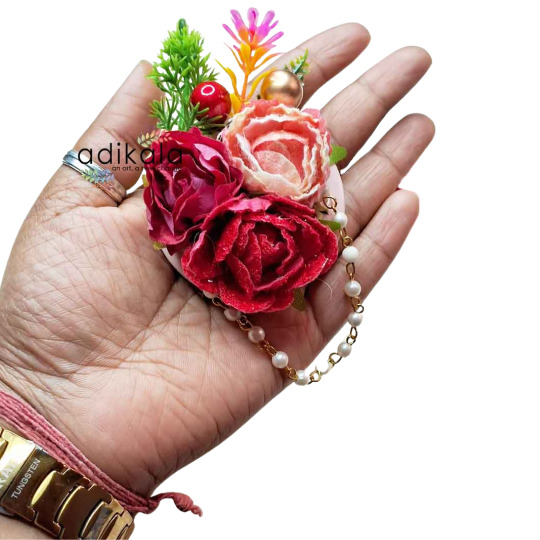
#art#decoration#decor#100 days of productivity#indianart#misha collins#craft#museums#mua#mp100#the bad batch#batch sealers#lehnga#sharee#chanderi dupatta online#chikankari kurti set with phulkari dupatta#kalamkari dupatta online#banarasi dupatta#kota doria dupatta#flowers#plants#floral#pink flowers#green#garden#artificialflower#artificialflowers
3 notes
·
View notes
Text
0 notes
Text
Stunning Kalamkari Painting for Artistic Home Enhancement
Add a touch of tradition with stunning Kalamkari painting. Its detailed, hand-painted designs bring artistic charm and cultural richness to your home decor. Learn More:
#kalamkari painting#indian contemporary art#laasya art gallery#traditional indian kalamkari paintings
0 notes
Text
Gandhigram Trust’s Samhita products on sale
#Gandhigram Trust’s Samhita products on sale #events #News
Gandhigram Trust’s Samhita products on sale Gandhi-Khadi_Naturals ~ Customers can buy contemporary Khadi readymade apparel, handmade block printed sarees, food items, personal care and home care products Gandhigram Trust is organising an exhibition of their Khadi readymade clothing range – Samhita – on the 6th and 7th of September, 2024 at CP Arts Centre, Eldams Road, Chennai from 10 am…
#Adambakkam News#Adambakkam Times#Alwarpet Times#Arcot road talk#Arts#Ashok Nagar News#Ashok Nagar Times#Chennai#Chennai News#Chennai times#Chennaiites#chennaites#chrompet news#Chrompet Times#ECR News#Ecr Times#entertainment#events#fabrics#Gandhigram Trust#Gandhigram Trust’s Samhita products#Gandhiji#hand-block printed towels#IndiGo#Kalamkari fabrics#Khadi#Kilpauk News#Kilpauk Times#Kodambakkam News#Kotturpuram Times
0 notes
Link
#kalamkari sarees online#kalamkari sarees from glam rani#GlamRani Sarees#ancient art kalamkari sarees#silk sarees#sareefashion#sareesonline#sareecollection
0 notes
Text
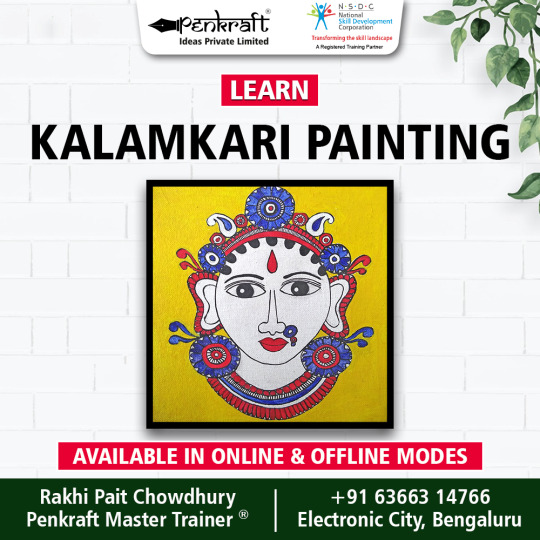
Join #Penkraft and learn #KalamkariPainting with #PenkraftMasterTrainer® Rakhi Pait Chowdhury at Electronic City, Bengaluru.
Available in Online and Offline mode.
Contact Rakhi Pait Chowdhury at +91 63663 14766 for registration and details.
Or visit us at: https://www.penkraft.in/Bangalore/ElectronicCity
#OnlineCourse#PenkraftOnline#PenkraftCourses#CertifiedCourse#LearnKalamkariPainting#Art#EthnicArt#ModernArt#kalamkari#kalamkariPaintings
0 notes
Text
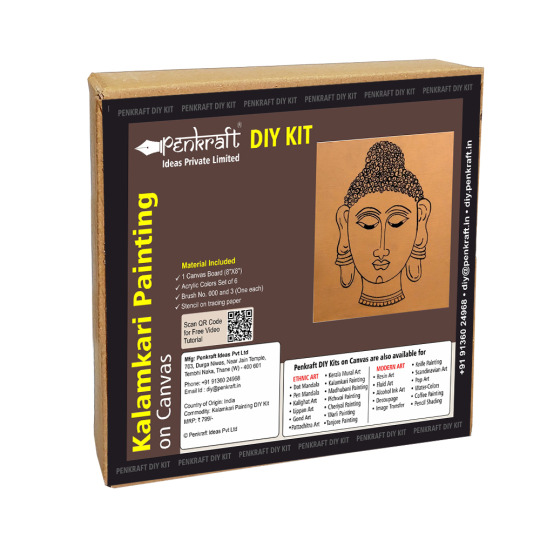
Penkraft Kalamkari Painting on Canvas DIY Kit | Free Video Tutorial Check out our vast DIY art kits collection exclusively made for anyone who wants to meet the hidden artist inside! Join Penkraft and be a DIY-er yourself.
0 notes
Text
instagram
#artwork#contemporary art#artoftheday#digital painting#art blog#painting#color#lifeisbeautiful#create#drawing#tribes#kalamkari#batikmodern#skechers#my draws#creature#photoart#photooftheday#photography#photografy#original phography#Instagram
1 note
·
View note
Text
Kalamkari Paintings – An Ancient Indian Art Form Kalamkari painting is a type of Indian folk painting that is done with a kalam, or pen. The word kalamkari means “pen work” in Hindi. Kalamkari paintings are a type of Indian folk art that is known for their intricate and beautiful designs. These paintings are created using a special type of dye known as kalam, which is made from the bark of certain trees. The kalamkari technique is a labor-intensive process that can take weeks or even months to complete.
0 notes
Text
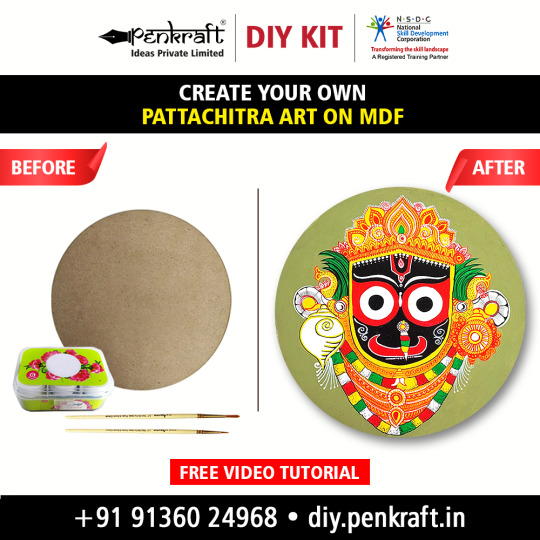
Penkraft's DIY Kits contain all material and tools that you need to undertake an art or craft activity - be it ethnic art forms, modern art forms or calligraphy.... And each DIY Kit comes with a Video Tutorial that teaches you how to use the material and create an amazing piece of art from ordinary objects!
#Penkraft DIY Kits#Pen Mandala DIY Kits#Resin Art DIY Kits#Fluid Art DIY Kits#Alcohol Ink DIY Kits#Dot Mandala DIY Kits#Gond Art DIY Kits#Warli Painting DIY Kits#Lippan Art DIY Kits#Decoupage DIY Kits#Image Transfer DIY Kits#Kalamkari DIY Kits#Kalighat DIY Kits#Knife Painting DIY Kits#Pop Art DIY Kits#One Stroke Painting DIY Kits#Brush Pen Calligraphy DIY Kits#Cut Nib Calligraphy DIY Kits#Devanagari Calligraphy DIY Kits#pattachitra art#art#artsy
0 notes
Text
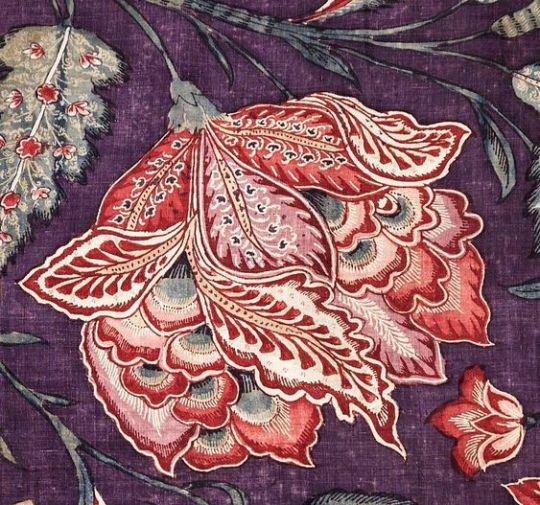
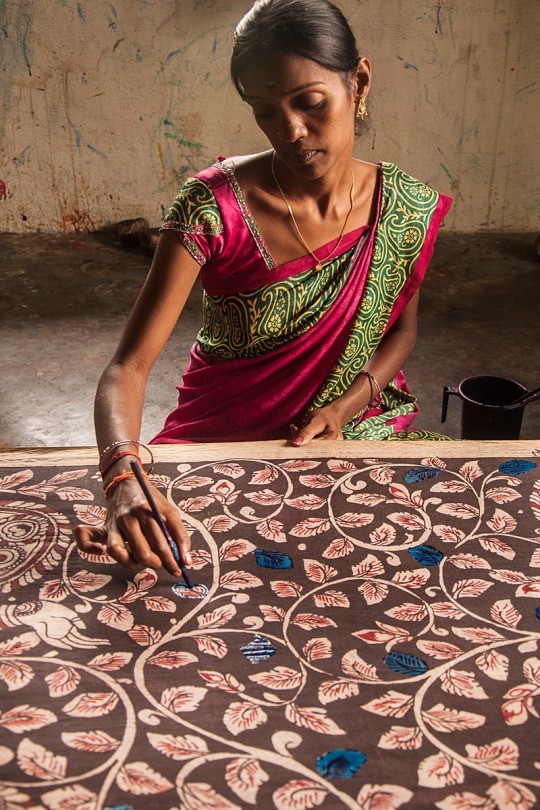
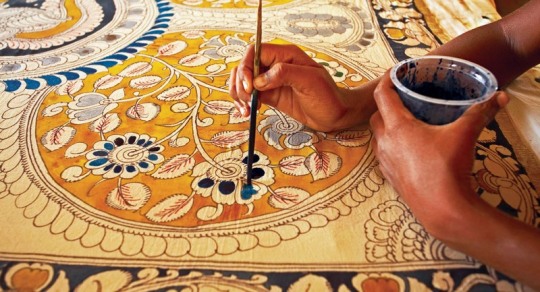
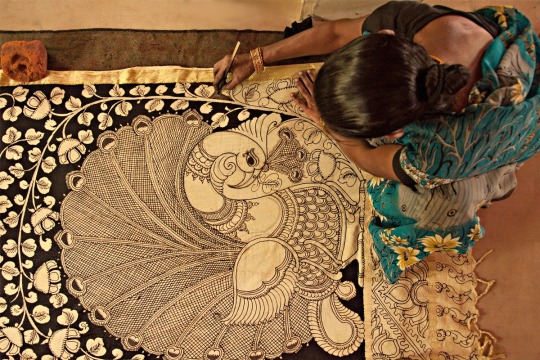
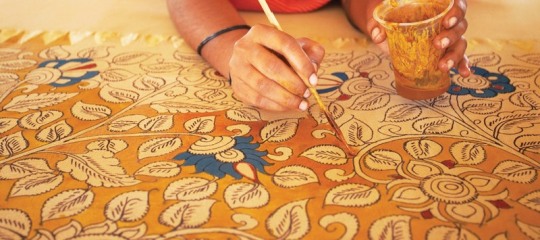
Kalamkari textiles of India.
The Persian name Kalamkari or ‘qalamkari’ is derived from the words kalam (pen) and kari (craftmanship) which translates into drawing using a pen. While there is a mention of these fabrics in ancient scriptures, this art received great patronage during the 16th-17th centurywhen the Golconda Sultanate ruled the Deccan. These wealthy sultans supported this craft and so did the Mughals who were their successors. It was also popular with the British who used these textiles for decorative purposes. Influenced by the Persian school of art, Kalamkari is being practiced for centuries in Andhra Pradesh and the artisans who practiced this art were known as ‘qalamkars’.
The entire process of manufacture is complex and involves as many as 17 steps with multiple rounds of dyeing, washing and boiling the fabric. The initial fabric is sourced from various places like Coimbatore, Erode and Tirupur in Tamil Nadu which is first washed thoroughly to remove any impurities in the form of grease, wax and dirt.
93 notes
·
View notes
Text
Discover Unique Art at Laasya Art Gallery in Austin, Texas
Explore a diverse collection of contemporary and traditional art at Laasya Art Gallery, showcasing emerging and established artists. Find the perfect piece for your collection. Learn More
#top-rated Indian art gallery#Traditional Indian Kalamkari Paintings#Indian Contemporary Art#Modern Indian Artists#Laasya Art Gallery
0 notes
Text
Why Hand-Painted Dupattas Are a Must-Have in Your Wardrobe

The Uniqueness of Hand-Painted Dupattas
1: What is a Hand-Painted Dupatta?
A hand painted dupatta is more than just a piece of fabric; it’s a canvas of art. Traditionally worn by women in South Asia, these dupattas are adorned with unique designs created by skilled artisans. Unlike mass-produced fabrics, which often lack personality, hand-painted dupattas showcase the individual artist’s touch.
When you compare machine-printed fabrics to hand-painted ones, the difference is striking. Machine prints can often feel generic, while hand-painted designs are infused with creativity and craftsmanship. In today’s fast-fashion world, where trends come and go, hand-painted dupattas stand out for their timeless beauty and authenticity. They remind us of the value of handcrafted designs, inviting us to slow down and appreciate true artistry.
2: Why Hand-Painted Dupattas Are Special
What makes hand-painted dupattas so special? It’s the personal touch that goes into creating each piece. The craftsmanship behind each dupatta ensures that no two are alike, guaranteeing a unique addition to your wardrobe. When you wear a hand-painted dupatta, you’re not just wearing a fashion accessory; you’re wearing a story that reflects the artisan’s passion and skill. This unique charm elevates any outfit, making it truly one of a kind.
3: Traditional Art Techniques in Hand-Painting
Hand-painted textiles have deep roots in various cultures, especially in countries like India and Nepal. Techniques such as Madhubani, Pattachitra, and Kalamkari showcase the rich traditions of hand-painting. Each method has its own unique characteristics and stories, adding layers of cultural significance to the dupatta.
Modern innovations in hand-painted textile art have expanded these traditional techniques, blending them with contemporary styles. The result? A beautiful fusion of the past and present, perfect for today’s fashionistas.
4: Benefits of Owning Hand-Painted Dupattas
Investing in a hand-painted dupatta for women is a decision you won’t regret. For starters, these pieces are timeless. Unlike fleeting fashion trends, hand-painted dupattas never go out of style. They can effortlessly transform an ordinary outfit into something extraordinary, adding a splash of color and creativity.
Moreover, high-quality fabric and paint are used, ensuring that your dupatta lasts for years to come. With proper care, these vibrant pieces can remain stunning and fresh, making them a valuable addition to your wardrobe.
5: Versatility: Styling Hand-Painted Dupattas
One of the best features of hand-painted dupattas is their versatility. Whether you’re dressing up for a wedding or looking for a chic accessory for everyday wear, there’s a way to style a dupatta for women for every occasion. Pair them with traditional outfits like kurtis and sarees, or even add them to western attire for a fusion look.
For casual outings, you can throw on a hand-painted dupatta over a simple outfit to create an effortlessly stylish appearance. And for festive events, the vibrant colors and intricate designs will ensure you stand out. With just a few styling tips, you can make your hand-painted dupatta the star of your ensemble!
The Cultural and Sustainable Impact of Hand-Painted Dupattas
6: Supporting Local Artisans and Traditional Craftsmanship
By choosing a hand-painted dupatta, you’re supporting local artisans and promoting traditional craftsmanship. Each purchase helps sustain artisan communities, allowing them to continue their time-honored practices. In an era where ethical fashion is gaining importance, hand-painted items offer a way to contribute to sustainable livelihoods and preserve cultural heritage.
Additionally, as modern fashion trends embrace these beautiful pieces, traditional crafts are experiencing a revival. This means that not only do you get a stunning piece of art to wear, but you also play a role in preserving history.
7: The Environmental Benefits of Hand-Painted Dupattas
When it comes to environmental impact, hand-painted dupattas shine brightly. Compared to machine-made textiles, they often have a lower carbon footprint. The slow fashion movement emphasizes quality over quantity, and hand-painted items align perfectly with this philosophy.
Moreover, many artisans use eco-friendly dyes and sustainable fabrics, making these dupattas not just beautiful but also kind to the planet. By choosing a hand-painted dupatta, you’re making a conscious choice for both your wardrobe and the environment.
8: Hand-Painted Dupattas as Art Pieces
Owning a hand-painted dupatta is like possessing a piece of art. Each design reflects the artist’s creativity and talent, allowing fashion to double as a form of art appreciation. Many dupattas draw inspiration from famous art movements or renowned pieces, making them unique treasures in your wardrobe.
9: The Timeless Appeal of Hand-Painted Dupattas
Hand-painted dupattas are not just trendy items; they are heirloom pieces meant to be passed down through generations. Their timelessness stands in stark contrast to the fast-fashion trends that often fade away. Fashion enthusiasts and art lovers alike see these dupattas as collectible items, celebrating the fusion of fashion and art.
10: How to Care for Hand-Painted Dupattas
To keep your hand-painted dupatta looking vibrant and fresh, it’s essential to care for it properly. Hand wash your dupatta in cold water with mild detergent, avoiding harsh chemicals. Store it in a cool, dry place away from direct sunlight to prevent fading. By following these best practices, you can maintain the beauty and integrity of your paintings apparel for years to come.
11: Where to Buy Hand-Painted Dupattas
If you’re eager to add a hand-painted dupatta for women to your wardrobe, look for reputable online stores or artisan markets like Palette Vibes. Ensure that you consider factors like authenticity, materials, and craftsmanship. Shopping from trusted sources, such as Palette Vibes, not only guarantees quality but also supports the artisans who create these beautiful pieces.
Conclusion
hand-painted dupattas are a must-have for anyone looking to enrich their wardrobe with unique, versatile, and culturally significant pieces. These stunning dupattas, created by hearing-impaired artists supported by Creative People NGO and promoted globally by Palette Vibes, bring a special touch to any outfit. Not only do they showcase beautiful artistry, but they also promote sustainability and support talented artisans. So, embrace the vibrant world of hand-painted dupattas, and experience the beauty, craftsmanship, and meaningful impact they bring to your wardrobe!
youtube
Crafted by Indian Artists for the World
Palette Vibes collaborates with artists across India to bring their creative visions to life. These artists, who specialize in intricate watercolor and acrylic paintings, pour their heart into each piece, which is then digitized for a seamless transfer onto our dupattas. By wearing one of our dupatta for women, you not only add elegance to your wardrobe but also support the Indian artist community, helping them gain global recognition.
Supporting Specially Abled Artists
Our mission goes beyond fashion. We are proud to work with non-profit organizations to uplift specially abled artists. These talented individuals have a unique perspective on the world, and their artwork is nothing short of extraordinary. With every purchase, you contribute to providing them a sustainable income, empowering them to live with dignity and independence.
Join Our Movement
Palette Vibes invites you to join our mission to support Indian artists and showcase their exceptional craftsmanship on a global platform. Every hand painted dupatta you purchase contributes to this vision of artistic empowerment, cultural preservation, and creative collaboration.
FAQ 1: What makes hand-painted dupattas different from printed ones?
Ans: Hand-painted dupattas are crafted by skilled artisans, with each piece being unique due to the manual painting process. Printed dupattas are mass-produced and lack the personal touch and intricate detailing found in hand-painted versions.
2: How do I style a hand-painted dupatta? Ans: Hand-painted dupattas can be styled with both traditional outfits like sarees and kurtis, and modern outfits such as dresses or tunics. The key is to let the dupatta be the highlight by keeping the rest of the outfit simple.
3: Are hand-painted dupattas durable? Ans: Yes, they are quite durable, especially if made with high-quality materials and eco-friendly paints. Proper care, such as gentle washing and careful storage, will ensure they last for years.
4: Are hand-painted dupattas sustainable? Ans: Hand-painted dupattas are more sustainable than mass-produced textiles because they often use natural dyes and are made in small batches by artisans, contributing to slow fashion.
5: Where can I buy authentic hand-painted dupattas? Ans: You can find authentic hand-painted dupattas from artisan markets, online platforms supporting traditional crafts, or boutique stores that specialize in handcrafted fashion. or you can find in Palette Vibes website
#Palette Vibes#Indian Art#Indian clothing#Dupatta#Hand Painted Dupatta#Fashion#indian fashion#Trending Fashion#Creative People#Youtube
2 notes
·
View notes
Text
Kalamkari painting on cotton, an art form traditional to Andhra Pradesh, southern India, “Divine Lovers Radha Krishna”

2 notes
·
View notes